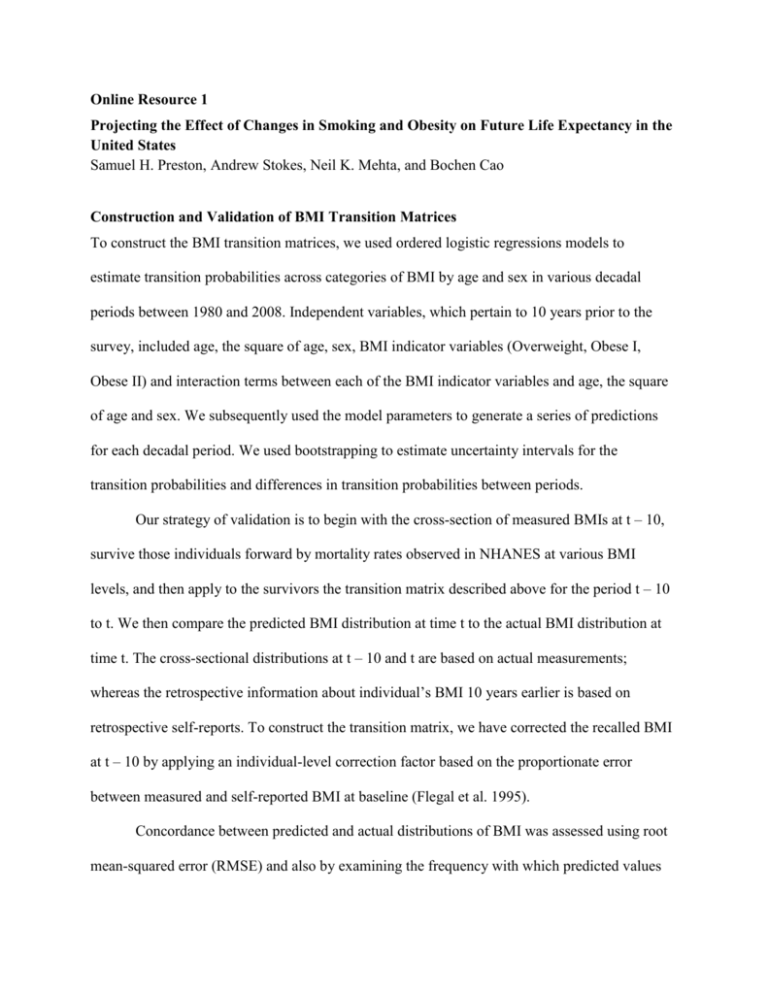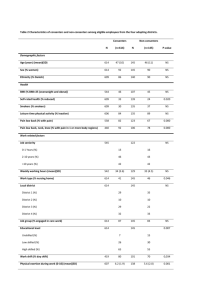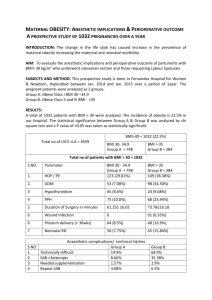Online Resource 1 Projecting the Effect of Changes in Smoking and
advertisement

Online Resource 1 Projecting the Effect of Changes in Smoking and Obesity on Future Life Expectancy in the United States Samuel H. Preston, Andrew Stokes, Neil K. Mehta, and Bochen Cao Construction and Validation of BMI Transition Matrices To construct the BMI transition matrices, we used ordered logistic regressions models to estimate transition probabilities across categories of BMI by age and sex in various decadal periods between 1980 and 2008. Independent variables, which pertain to 10 years prior to the survey, included age, the square of age, sex, BMI indicator variables (Overweight, Obese I, Obese II) and interaction terms between each of the BMI indicator variables and age, the square of age and sex. We subsequently used the model parameters to generate a series of predictions for each decadal period. We used bootstrapping to estimate uncertainty intervals for the transition probabilities and differences in transition probabilities between periods. Our strategy of validation is to begin with the cross-section of measured BMIs at t – 10, survive those individuals forward by mortality rates observed in NHANES at various BMI levels, and then apply to the survivors the transition matrix described above for the period t – 10 to t. We then compare the predicted BMI distribution at time t to the actual BMI distribution at time t. The cross-sectional distributions at t – 10 and t are based on actual measurements; whereas the retrospective information about individual’s BMI 10 years earlier is based on retrospective self-reports. To construct the transition matrix, we have corrected the recalled BMI at t – 10 by applying an individual-level correction factor based on the proportionate error between measured and self-reported BMI at baseline (Flegal et al. 1995). Concordance between predicted and actual distributions of BMI was assessed using root mean-squared error (RMSE) and also by examining the frequency with which predicted values of the proportion of individuals in various BMI categories fell within the 95 % confidence intervals (CI) of actual values. We conducted the validation separately for each of three periods: 1980–1990, 1990–2000, and 2000–2010. The transition matrix pertaining to 1997/1998 to 2007/2008 was used in the latter analysis because no later data were available. Results are shown in Table S1.1. It is clear that the predicted BMI distributions in 1990, 2000, and 2010 closely track the rightward shift in the BMI distribution that occurred over this period in all age groups. For purposes of assessing the discrepancy between predicted and observed distributions of individuals across categories of age and BMI, the data were organized into three age groups (35–54, 55–69, and 70–84) and four BMI intervals (Normal, Overweight, Obese I, and Obese II). RMSE was calculated separately for each of the three prediction periods (1990, 2000, and 2010) by comparing values across ages and BMI categories (for a total of 12 values per period). RMSE were 1.81, 2.09, and 1.74 for 1990, 2000, and 2010, respectively. Concordance was also assessed by examining whether predicted values were within the 95 % CI of observed values. There was a good concordance between the actual and observed proportions using this criterion. For the first of the three outcome years, three of the 12 comparisons of predicted to actual proportions showed a predicted proportion that was outside the 95 % CI of the observed proportion. For the second and third outcome years, only two of the 12 predicted values were outside the 95 % CI of the observed proportion. We conclude that the retrospective reports on BMI 10 years earlier successfully trace the dynamics of the huge increase in obesity that occurred over a period of three decades. Table S1.1 Comparison of predicted and actual obesity distributions (95 % confidence intervals (CI)) by age and period 1990b 2000c 2010d Age (y) BMI Cat. (kg/m2) 35–54 <25 39.01 40.43 (37.60-43.27) 30.64 32.83 (30.06-35.59) 25.22 28.39 (25.68-31.11) 25 to 30 35.50 34.30 (32.59-36.02) 34.40 35.36 (33.15-37.56) 34.02 34.03 (31.50-36.57) 30 to 35 16.19 15.55 (13.92-17.19) 18.77 17.65 (16.09-19.20) 22.24 20.38 (18.49-22.27) 55–69 70–84 a Predicted Value Actual (95 % CI) Predicted Value Actual (95 % CI) Predicted Value Actual (95 % CI) >35 9.32 9.71 (8.00-11.42) 16.14 14.17 (12.03-16.31) 18.53 17.19 (15.36-19.02) <25 35.94 32.33 (29.88-34.79) 27.11 26.21 (23.64-28.78) 24.98 23.13 (19.91-26.36) 25 to 30 36.57 38.12 (35.29-40.95) 33.63 35.64 (32.93-38.36) 33.39 35.15 (30.73-39.57) 30 to 35 17.76 20.30 (18.37-22.24) 21.44 22.69 (20.64-24.74) 21.79 23.13 (18.92-27.35) >35 9.79 9.24 (7.79-10.70) 17.85 15.45 (12.62-18.29) 19.83 18.58 (16.24-20.92) <25 43.78 41.11 (38.42-43.80) 32.66 32.13 (28.93-35.32) 25.51 22.93 (19.32-26.53) 25 to 30 35.43 37.91 (35.86-39.96) 36.84 41.25 (37.49-45.00) 35.85 36.15 (30.76-41.55) 30 to 35 14.56 14.62 (12.56-16.68) 19.51 18.69 (15.81-21.57) 21.53 23.64 (20.50-26.78) >35 6.28 6.37 (5.11-7.63) 10.93 7.94 (6.27-9.60) 17.10 17.28 (13.45-21.10) RMSE 1.81 2.09 1.74 RMSE = root mean-squared error. This metric was used to assess error in predictions and was calculated within each period by comparing predicted to actual BMI values across age categories. b Sources of data for 1990 prediction: Initial population counts: National Health and Nutrition Examination Survey (NHANES) 2 (1976–1980); life tables: NHANES 2 (1976–1980) with mortality follow-up through 1992; transition probabilities and validation data: NHANES 3 (1988– 1994). Ten-year recall weight was corrected prior to estimating transition probabilities. c Sources of data for 2000 prediction: Initial population counts: NHANES 3 (1988–1994); life tables: NHANES 3 (1988–1994) with mortality follow-up through 2006; transition probabilities and validation data: NHANES Cts. (1999–2002). Ten-year recall weight was corrected prior to estimating transition probabilities. d Sources of data for 2010 prediction: Initial population counts: NHANES Cts. (1999–2002); life tables: NHANES 3 (1988–1994) and NHANES Cts. (1999–2004) with mortality follow-up through 2006; transition probabilities: NHANES Cts. (2007–2008); validation data: NHANES Cts. (2009–2010). Ten-year recall weight was corrected prior to estimating transition probabilities. a








